|
|
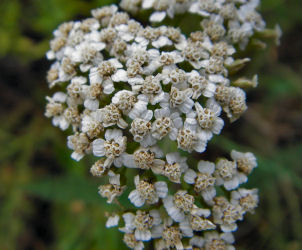 |
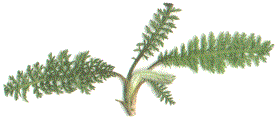
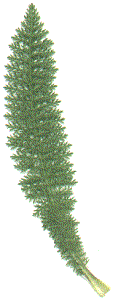
 Yarrow is a very hardy perennial that's native to Eurasia, but is widely naturalized in the United States. There is also a native American species (which may be identical) known as Achillea lanulosa (Woolly and/or Western Yarrow). I find Yarrow in grassy areas and old fields, along fence lines, roadsides and other edges, and sometimes in lawns. It does better in rich soil, but doesn't require it to be very good, though it does need decent drainage. It prefers full sun, but will tolerate being partly shaded. Yarrow is drought tolerant and is generally resistant to insects and disease, but may suffer from mildew or rust. Yarrow spreads quickly from a system of shallow roots and also from seed and can be quite invasive.
Yarrow is a very hardy perennial that's native to Eurasia, but is widely naturalized in the United States. There is also a native American species (which may be identical) known as Achillea lanulosa (Woolly and/or Western Yarrow). I find Yarrow in grassy areas and old fields, along fence lines, roadsides and other edges, and sometimes in lawns. It does better in rich soil, but doesn't require it to be very good, though it does need decent drainage. It prefers full sun, but will tolerate being partly shaded. Yarrow is drought tolerant and is generally resistant to insects and disease, but may suffer from mildew or rust. Yarrow spreads quickly from a system of shallow roots and also from seed and can be quite invasive.
I brought home just one small plant early one summer. The original plant is in the background of the photo below on the right, which I took a couple of months later. Maybe since it doesn't mind if you mow it or walk on it, I'll move it to the yard next year before it crowds out the strawberries. In early spring, the perennial roots send up a rosette of long, feathery, stalked leaves. This is followed by a fuzzy, hairy flower stalk, which has shorter, alternate, unstalked leaves that are often rather sparse. The whole plant generally grows one to three feet tall, and is pleasantly aromatic. |
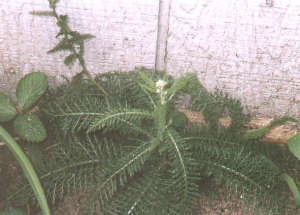
The white, or sometimes pink, flowers appear in flat-topped clusters, beginning in early summer and continuing through early fall. The flowers are small, about a quarter inch in diameter, and are composed of four to six, but usually five, ray flowers, generally more wide than long with three teeth at their tips. The ray flowers encircle lots of little disk flowers. The flowers bloom for a long time, but eventually they produce seed and die. The dry flower stalks and seed heads remain standing through winter. The basal leaves also often persist through the winter and may still be green when the snow melts in the spring. |
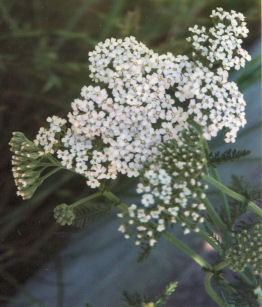
Yarrow has been used as a medicine for ages. The genus name, Achillea, honors the Greek hero Achilles, who is said to have used yarrow on the battlefield to staunch the bleeding of his men's wounds. Yarrow is also a traditional women's herb, used to ease menstruation. For medicinal use, either harvest the whole plant (from the ground up) while it's in flower, or harvest the leaves just before the plant flowers. The leaves are medicinally strongest just before flowering, and the flowers are stronger than the leaves. Externally, yarrow is styptic (stops bleeding), astringent (makes tissue contract), antiseptic (inhibits bacterial growth), vulnerary (helps tissue heal), anti-inflammatory, and possibly anesthetic. For external use, generally either the fresh or dried plant material is used as a poultice, or a tea made from the plant is used in compresses or as a wash. It's also sometimes used in ointments. Internally, the tea is a very good diaphoretic (raises the body temperature and makes you sweat). It also makes a bitter tonic which stimulates digestion. Additionally, it's expectorant, carminative (dispels gas), hemostatic (another way of saying it stops bleeding), astringent, antibiotic, anti-inflammatory, antispasmodic, analgesic, stimulant, and emmenagogue. Yarrow is a general tonic for the It is often true that the differences between food, medicine, and poison are a matter of dosage. Yarrow should be treated with respect and used sparingly. Extended or excessive use, internal or external, is likely to cause photosensitivity. You may be allergic to yarrow, handling the plant gives some people a rash. Yarrow has also been used as food. The tea is consumed as a beverage, and the plant has been used to flavor beer, wine, and soft drinks. The leaves can be used as a seasoning (somewhat like sage), and the flowers make a stronger seasoning. The young leaves have been boiled as greens, and the very young leaves added to salads. In the United States, yarrow's use in commercial products is restricted by its official FDA listing as safe as a flavoring in beverages only, and only if the finished product is thujone free. Animals don't often eat yarrow, but when they do, usually they only eat the flowers. Yarrow is undesirable in cow pastures because when cows eat it it makes the milk taste bitter. The foliage repels insects. The flowers attract ladybugs, bees, and butterflies.
You can buy varieties of yarrow that flower in assorted shades of white, yellow, and red. If you cut the flowers before they start to fade, and dry them, they keep their color well and are good for floral arrangements. The flowers are also good in potpourri. The flowers yield a yellow to light green dye. Yarrow stalks have traditionally been used to consult the I Ching (you'll need fifty stalks between fifteen and twenty inches long).
Selected References
|
|
| Home | About this site | Asides/Glossary | Store |
| Taxonomy Tree | Species list | Article list | |
|
Featured sponsors:
|
Mountain Rose Herbs Bulk herbs, teas, oils, & much more! |
Richter's Herbs Seeds & plants |
|
|
© 1999-2015 by Deb Schwartz. All rights reserved. Please send feedback to: deb@kingdomplantae.net Website by ki-yi.com
|
|||